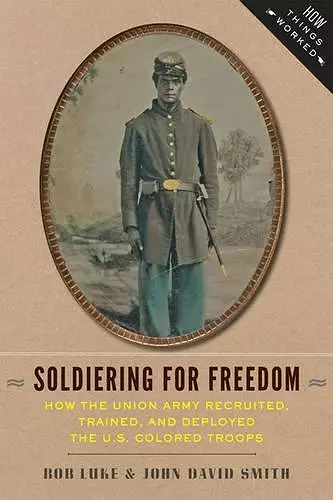Soldiering for Freedom
How the Union Army Recruited, Trained, and Deployed the U.S. Colored Troops
John David Smith author Bob Luke author
Format:Hardback
Publisher:Johns Hopkins University Press
Published:11th Jul '14
Currently unavailable, and unfortunately no date known when it will be back
This hardback is available in another edition too:
- Paperback£17.50was £17.50(9781421413600)

The story of an enormous step forward in both the struggle for black freedom and the defeat of the Confederacy: turning former enslaved men into Union soldiers.
Colored Troops, Union military strategy, and race relations during and after the tumultuous Civil War.After President Lincoln issued the final Emancipation Proclamation of January 1, 1863, Confederate slaves who could reach Union lines often made that perilous journey. A great many of the young and middle-aged among them, along with other black men in the free and border slave states, joined the Union army. These U.S. Colored Troops (USCT), as the War Department designated most black units, materially helped to win the Civil War - performing a variety of duties, fighting in some significant engagements, and proving to the Confederates that Northern manpower had practically no limits. Soldiering for Freedom explains how Lincoln's administration came to recognize the advantages of arming free blacks and former slaves and how doing so changed the purpose of the war. Bob Luke and John David Smith narrate and analyze how former slaves and free blacks found their way to recruiting centers and made the decision to muster in. As Union military forces recruited, trained, and equipped ex-slave and free black soldiers in the last two years of the Civil War, white civilian and military authorities often regarded the African American soldiers with contempt. They relegated the men of the USCT to second-class treatment compared to white volunteers. The authors show how the white commanders deployed the black troops, and how the courage of the African American soldiers gave hope for their full citizenship after the war. Including twelve evocative historical engravings and photographs, this engaging and meticulously researched book provides a fresh perspective on a fascinating topic. Appropriate for history students, scholars of African American history, or military history buffs, this compelling and informative account will provide answers to many intriguing questions about the U.S. Colored Troops, Union military strategy, and race relations during and after the tumultuous Civil War.
This book is a perfect introduction to its subject for undergraduate students. Interwoven as it is with larger questions of race and masculinity, military organization and professionalism, and nationalism and citizenship students will be introduced to the complexities that surrounded emancipation and the meanings of freedom and the war. -- David Carlson Civil War Book Review This brief and useful study synthesizes a welter of important scholarship on race, soldiering, emancipation, and the quest for citizenship by African Americans... Besides analyzing experiences of African American, Luke and Smith expertly explain civil war Army life and the soldier's craft. Choice In Soldiering for Freedom... independent scholar Bob Luke and historian John D. Smith attempt not to break new ground, but to familiarize a wide readership with the findings of current scholarship on black soldiers in the Union Army. For the most part, their succinct book admirably achieves this aim. -- Donald R. Shaffer Michigan War Studies Review Detailed introduction to this important topic. -- Kathryn Shively Meier North Carolina Historical Review ... There is much to admire in Soldiering for Freedom. Luke and Smith have produced an account of wide potential interest for a diverse readership. They combine sound research with a lucid writing style, free of jargon, and uncluttered by digressions into the debates and trends in Civil War literature. The Journal of African American History
ISBN: 9781421413594
Dimensions: 229mm x 152mm x 15mm
Weight: 318g
144 pages